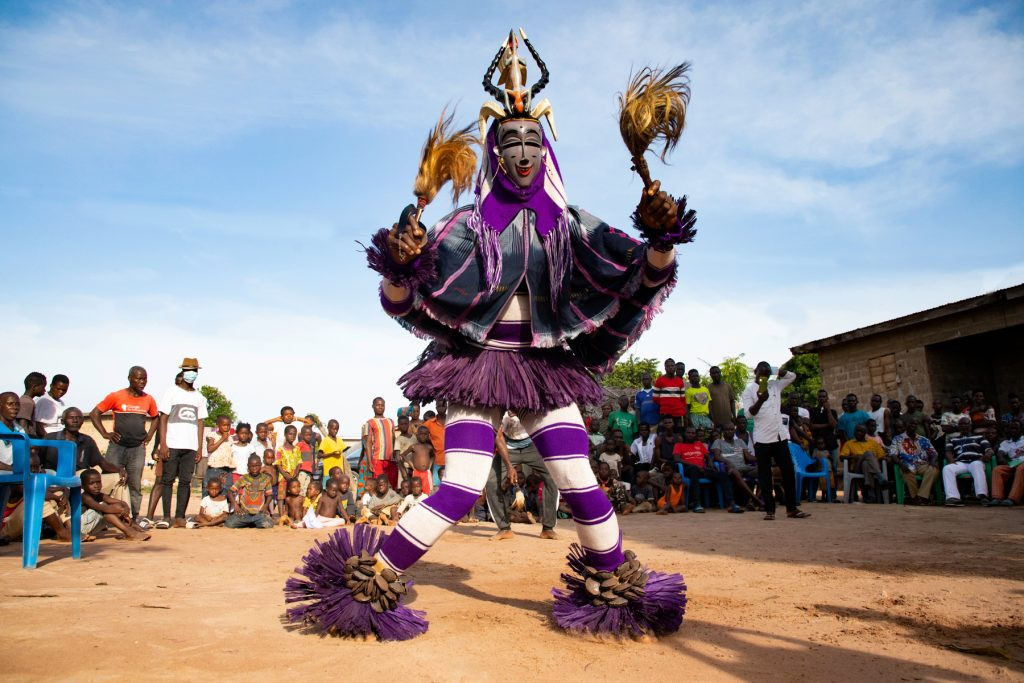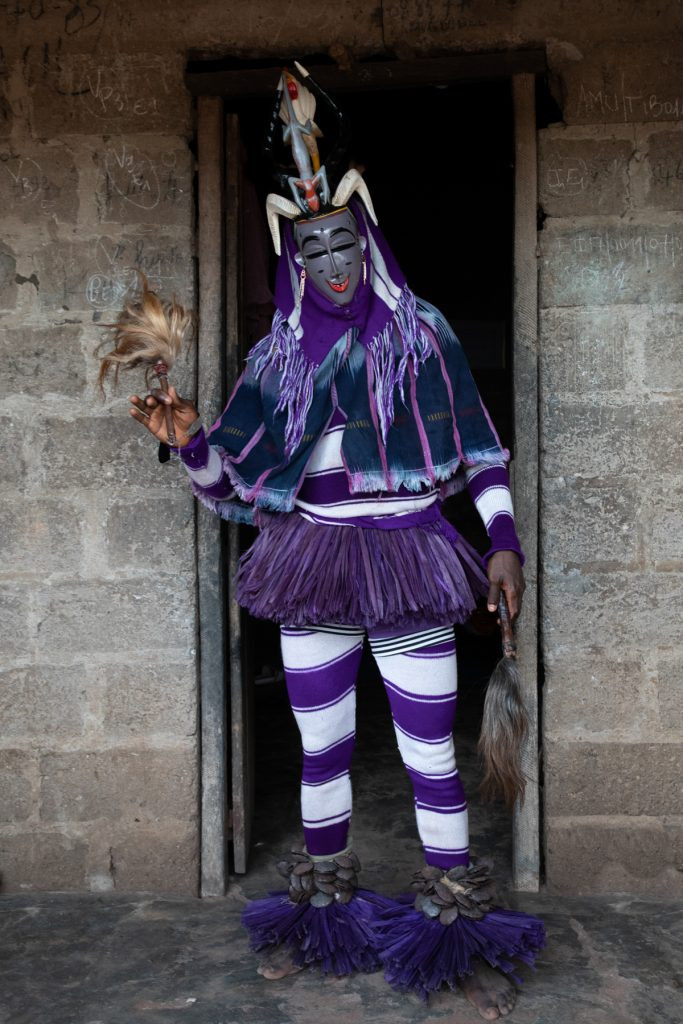Have you ever encountered a dance so captivating it seems to defy human limitations? The Zaouli Dance, originating from the heart of West Africa, has mesmerized audiences worldwide, going viral across platforms like TikTok, Facebook, and Instagram. Its seemingly superhuman leg movements, performed while the dancer’s body remains remarkably still, are truly a sight to behold.
Driven by the allure of witnessing Zaouli firsthand, we journeyed to Ivory Coast (Côte D’Ivoire), a gem often overlooked in West Africa. Home to the Guro people, Ivory Coast and the Zaouli dance exceeded all expectations, offering an unforgettable cultural experience.
The Zaouli dance is a relatively recent cultural phenomenon in Ivory Coast, conceived in the 1950s. Legend attributes its creation to inspiration from a young Guro girl named Djela Lou Zaouli, meaning “Lion’s daughter.” Today, the masks worn by Zaouli dancers are generically known as Djela, in her honor.
Performed during significant celebrations and funeral ceremonies, Zaouli is believed to bring prosperity and unity to Guro communities. It serves as a vibrant expression of their cultural identity and heritage.
 Mesmerizing Zaouli Dance Performance in Ivory Coast: Witness the incredible energy and intricate footwork of a Zaouli dancer in action.
Mesmerizing Zaouli Dance Performance in Ivory Coast: Witness the incredible energy and intricate footwork of a Zaouli dancer in action.
Bouaflé: The Global Epicenter of Zaouli Dance
Zaouli’s roots are firmly planted in Bouaflé, a modest region in Ivory Coast, and to a lesser extent in the neighboring Zuénola, situated north of Yamoussoukro. Before the emergence of Zaouli, Guro culture remained relatively unknown on Ivory Coast’s anthropological landscape. Now, this extraordinary dance has propelled Bouaflé onto the global stage.
Zaouli’s captivating performances have graced stages across Europe and Asia, and are a highlight at major African celebrations like Festima in Burkina Faso. This dynamic dance has not only brought recognition to the Guro people but has also amplified the cultural richness of Ivory Coast as a whole.
In 2017, Zaouli’s global significance was formally recognized when UNESCO added it to the Representative List of the Intangible Cultural Heritage of Humanity, solidifying its place as a treasure of world culture.
 Intricate Zaouli Mask of Sortanvani in Ivory Coast: A close-up view of the Sortanvani mask, representing weavers in Guro culture, part of the Zaouli dance tradition.
Intricate Zaouli Mask of Sortanvani in Ivory Coast: A close-up view of the Sortanvani mask, representing weavers in Guro culture, part of the Zaouli dance tradition.
Decoding the Zaouli Mask
Within the Zaouli tradition, seven distinct mask types exist. During our exploration, we were fortunate to witness three: Zohoulin, Gan, and Sortanvani, each carrying unique symbolism.
Despite being named after a woman, Zaouli is exclusively performed by men, with the tradition often passed down through families.
Becoming a proficient Zaouli dancer demands rigorous dedication, typically taking around seven years to master the intricate movements. The dance is physically taxing, and during a performance, a Zaouli dancer engages in a silent dialogue with the audience. Maintaining stillness in the upper body while executing a breathtaking array of leg movements is key. Remarkably, dancers are forbidden from repeating steps within a single performance. The complexity and fluidity of their footwork are truly mesmerizing, captivating all who watch.
 Dynamic Zaouli Gan Dance in Bouaflé, Ivory Coast: Observe the powerful and unique movements of a Zaouli dancer wearing the Gan mask during a captivating performance.
Dynamic Zaouli Gan Dance in Bouaflé, Ivory Coast: Observe the powerful and unique movements of a Zaouli dancer wearing the Gan mask during a captivating performance.
Typically, a Zaouli dancer enters the performance arena with his Djela mask veiled in local woven cloth, accompanied by a guardian who ceremoniously unveils him as the dance commences. The costume usually includes a striped bodysuit, raffia wrist and ankle bands, and a raffia skirt. Adding to the auditory richness of the performance, dancers often adorn their ankles with bells or seed pods, their sounds harmonizing with the wild drumming and horn music that propels the dance.
 Traditional Zaouli Dance Costume Detail: Raffia anklets and metal bells adorn the legs of a Zaouli dancer, enhancing the rhythmic sounds of this Ivorian dance.
Traditional Zaouli Dance Costume Detail: Raffia anklets and metal bells adorn the legs of a Zaouli dancer, enhancing the rhythmic sounds of this Ivorian dance.
Witnessing Zaouli in Bouaflé: A Cultural Immersion
Arriving in Bouaflé in the late afternoon, we found ourselves drawn into a gathering of locals, eager to witness Zaouli. A source of immense cultural pride and a blessing for the village, Zaouli performances attract people from across the Bouaflé region.
A Master of Ceremonies, in our case, a village elder impeccably dressed in a suit featuring Angola’s traditional warrior print, Shanakaka, marked the beginning. This unexpected fusion of cultural elements sparked curiosity about the influences shaping Ivorian traditions.
 Master of Ceremonies at a Zaouli Dance Event in Ivory Coast: An elder in traditional attire, acting as the Master of Ceremonies, welcomes the audience to a Zaouli dance performance.
Master of Ceremonies at a Zaouli Dance Event in Ivory Coast: An elder in traditional attire, acting as the Master of Ceremonies, welcomes the audience to a Zaouli dance performance.
Soon, a young boy in everyday clothes entered the dance arena. We quickly learned he was a budding Zaouli dancer, continuing a family legacy. His gestures commanded the attention of the growing crowd, who responded with excited anticipation and reverence. Even in training, the young dancer already possessed a repertoire of impressive moves. Between his practice sets, the captivated audience members showed their appreciation by offering him small tokens of money, reflecting the high esteem Zaouli dancers command, even in their formative years.
 Young Zaouli Dancer in Training in Ivory Coast: A glimpse into the future of Zaouli dance as a young boy practices the intricate steps, learning the traditional art form.
Young Zaouli Dancer in Training in Ivory Coast: A glimpse into the future of Zaouli dance as a young boy practices the intricate steps, learning the traditional art form.
Zohoulin and the Spirit of the Dance
The main Zaouli dancer, adorned with the grey Zohoulin mask, was then guided into the arena. The Zohoulin mask, one of the most iconic Djela, depicts a chicken consuming a lizard, symbolizing a historical triumph of the Guro people over neighboring groups. The dancer was seated briefly as the crowd swelled with excitement.
 Zaouli Dancer and Guardian Preparing for Performance in Bouaflé, Ivory Coast: A Zaouli dancer, guided by his guardian, awaits the cue to begin his captivating performance for the eager audience.
Zaouli Dancer and Guardian Preparing for Performance in Bouaflé, Ivory Coast: A Zaouli dancer, guided by his guardian, awaits the cue to begin his captivating performance for the eager audience.
We were fortunate to witness fleeting smiles from the dancer as he glanced at the adoring crowd. It’s understood that seeing a Zaouli dancer unmasked is a rare privilege, as they are not perceived as ordinary individuals during performances, but rather as embodiments of the spirit world. When they dance, it is believed their bodies are vessels for the spirits that possess them, enabling their extraordinary feats.
 Anticipation Before the Zaouli Dance Begins: A Zaouli dancer peeks out from behind his mask, showing a rare glimpse of the human behind the spirit, moments before his performance.
Anticipation Before the Zaouli Dance Begins: A Zaouli dancer peeks out from behind his mask, showing a rare glimpse of the human behind the spirit, moments before his performance.
With a nod from his guardian, the dancer rose. His Djela mask was unveiled, and he faced the crowd, acknowledging them with a nod and waving small whips made of animal fur. He moved deliberately, ensuring everyone’s attention was captured as the music intensified. Then, with explosive energy, he launched into a series of breathtaking movements, igniting the crowd into cheers and applause.
Following the Zohoulin performance, two more dances unfolded: the red Gan mask, representing the evasive strategies of game animals, and the orange Sortanvani mask, embodying the weavers of Guro culture.
Completely captivated, we wished the performance would never end. Afterward, we expressed our gratitude to the Master of Ceremonies, offering wine, gifts, and money as a token of appreciation for being included in such a significant celebration of Guro culture.
Beyond the Spectacle: Meeting the Zaouli Dancer
Expecting to be refused, we hesitantly requested to offer a gift directly to the dancer. Initially, we imagined only seeing him masked, never daring to hope for a glimpse of the person beneath.
We were led away from the arena to a modest building where Guro elders were gathered. Upon learning of our request, the Zaouli dancer himself emerged. Astonishment washed over us. When we asked if photography was permitted, anticipating a “No,” we were met with an unexpected “Yes.”
 Behind the Scenes with a Zaouli Dancer in Bouaflé, Ivory Coast: An intimate moment with a Zaouli dancer, unmasked and holding his Zohoulin mask, offering a rare look beyond the performance.
Behind the Scenes with a Zaouli Dancer in Bouaflé, Ivory Coast: An intimate moment with a Zaouli dancer, unmasked and holding his Zohoulin mask, offering a rare look beyond the performance.
The subsequent moments remain somewhat dreamlike. We found ourselves inside the small room, the unmasked Zaouli dancer showing us his various Djela masks and graciously allowing us to photograph him holding them. It was an incredibly intimate and unexpected privilege.
As we concluded our impromptu photo session, we offered a tip and heartfelt thanks to the dancer. Overwhelmed by the experience – witnessing Zaouli live after years of anticipation and the dancer’s extraordinary talent – a sense of awe and emotion lingered as we departed.
 Unveiling the Man Behind the Zaouli Mask: A truly special encounter with a Zaouli dancer without his mask, holding the Djela, providing a unique insight into this celebrated Ivorian tradition.
Unveiling the Man Behind the Zaouli Mask: A truly special encounter with a Zaouli dancer without his mask, holding the Djela, providing a unique insight into this celebrated Ivorian tradition.
We were incredibly fortunate to have this rare encounter. While future trips to Ivory Coast will undoubtedly include witnessing Zaouli performances again, this behind-the-mask experience was a serendipitous moment, a magical memory etched forever in our minds.
